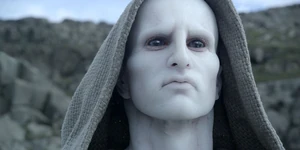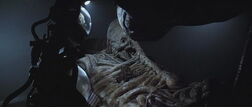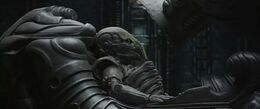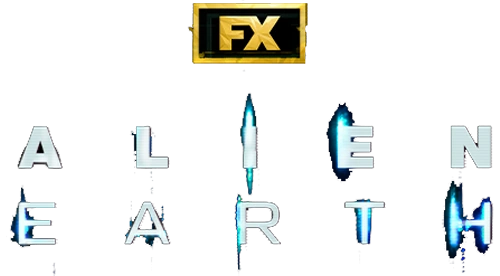
Individual Engineers have been observed to vary in appearance as well as abilities.
Appearance[]
Engineers are humanoid, hairless with very pale skin, through which many blood vessels are visible. Their eyes are said to be "dead seeming," with pupils shaped like oblong crosses.
Engineers stand 10.36 (3.14m) feet tall and, like humans, breathe oxygen. However they are seemingly able to withstand higher carbon dioxide concentrations than humans--they are able to breathe unassisted and unprotected on the surface of LV-223′s which has carbon dioxide concentrations that would be lethal to humans.
Engineers possess great physical strength, as demonstrated when one kills one of Peter Weyland's escorts by sending him flying across the room with a single punch.
History[]
Little is known about the Engineers' history, but the Engineers are shown to be the creators of the human race, visiting Earth during its primordial stage. On primordial Earth, a lone "Sacrificial Engineer" ingests an unknown substance, later revealed to be a black goo, causing his body to dissolve, which in turn seeds the planet with his DNA, hastening the evolutionary process. The Engineers continue to visit Earth to secretly observe the human race's development.
Approximately 2,000 years prior to the Prometheus expedition to LV-223, the Engineers stationed there formulated a plan to wipe out humanity, for reasons unknown, by releasing a pathogen they created for the purpose. However, later events suggest that they lose control of the pathogen leading to the deaths of all but four of the Engineers. The survivors take refuge aboard their ship, storing themselves in the vessel's Hypersleep Chambers on the vessel's bridge. However, even while this plan is being formed and executed, Engineers were still in the habit of visiting Earth, as a number of the artifacts seen at the beginning of Prometheus date from the 7th century CE.
In 2089, archaeologists Elizabeth Shaw and Charlie Holloway discovered 35,000-year-old cave paintings on the Isle of Skye on Earth depicting a tall figure pointing to a series of stars. This depiction matches similar illustrations found on artifacts from a variety of Earth cultures and time periods--cultures that did not and could not have any contact with each other. Shaw and Holloway interpret this common theme as referring to a specific set of stars within the galaxy and that their depiction in ancient Earth artifacts was the result of contact with an alien species. Shaw expresses the belief that these extra-terrestrial beings, whom she dubs "Engineers" caused the depictions to be created as an invitation for humans to make contact with them.
Shaw shares her findings with Peter Weyland, the elderly CEO of Weyland Corporation, who funds an expedition aboard the vessel Prometheus to the moon LV-223 in orbit around the star system depicted in the artifacts.
The Prometheus arrives at LV-223 in 2093, following a two-year journey. The crew explores the moon's surface where they come across an alien structure--built by the Engineers. While exploring the structure, the Prometheus crew discovers Engineer bodies, as well as several strange canisters that, unbeknownst to them, contain the Engineers' pathogen. The crew's interference with these canisters causes the pathogen to be released. This leads to a number of deaths among the crew either as a result of indigenous life mutated by the pathogen, direct mutation of members of the crew, or in attempts to deal with the fallout from those events. Meanwhile, the android David brings one of the canisters back aboard Prometheus and deliberately infects Holloway with the pathogen by spiking his drink.
The crew returns to the Engineer structure and tries to locate two missing crewmates. While doing so, the android David discovers a vessel within. He explores the ship and locates the bridge, containing the Hypersleep Chambers the Engineers had sealed themselves in. However, only one of the four has survived. David does not share his discovery with any of the crew.
Upon the crew's return to the Prometheus, David tells Shaw that she is pregnant. However, the fetus is not human, but the result of Shaw being infected by Holloway when the couple made love the night before. David then drugs Shaw with the intention of having her put her into cryosleep until the ship returns to Earth. Shaw manages to evade the crew sent to put her into cryosleep and makes her way to the medical bay. Once there, and in severe pain as the creature tries to exit her body, she performs surgery on herself. She removes a thrashing, grey, tentacled creature--a Trilobite--which the surgical equipment holds in place while she escapes the room, sealing the creature within.
Still suffering from her surgery, Shaw discovers that the elderly Peter Weyland has traveled aboard the Prometheus in secret, with the objective of '[meeting his] maker,' believing the Engineers can save him from death. David leads a party comprised of Weyland, Shaw, and two other members of the Prometheus crew to the Engineer ship, with the intention of reviving the surviving Engineer so that Weyland can converse with it.
They pass through the Engineer ship's cargo bay in which are stored thousands of canisters of pathogens. Upon reaching the bridge, David wakes the surviving Engineer and attempts to speak to him. The Engineer then turns hostile, decapitates David, and bludgeons Weyland with the head before killing the rest of the party except Shaw, who manages to escape.
The Engineer reactivates the ship and sets course for Earth, presumably to carry out the original mission of wiping out the human race. With Shaw still on the planet, the remaining crew of the Prometheus sacrifice themselves to prevent the Engineer ship's departure from LV-223, jettisoning the vessel's lifeboat for Shaw to use, before ramming the Engineer ship at full thrust, causing the alien craft to fall back to the planet.
Shaw enters the lifeboat and begins gathering supplies, when she hears thumping noises. She moves towards the noise which is coming from the medical bay she used earlier. Peering into the room, she is startled by an enormous tentacle slapping against the window from the other side--the Trilobite she removed earlier has grown to massive proportions. As she backs away, David (or rather his head) signals Shaw from the Engineer ship, warning her that she needs to leave as the Engineer is coming to find her. However, she only manages to move a few steps before the Engineer breaks into the lifeboat and pins her against the doors of the medical bay. Shaw activates the door controls releasing the Trilobite, which proceeds to ensnare the Engineer, while Shaw (just about) makes her escape.
The Engineer and Trilobite grapple with each other, the Trilobite gradually wrapping more and more of itself around the Engineer. It moves its central mass forward, flowering open to reveal a toothed maw surrounded by what look like eyes. The eyes turn out to be slender tentacles which it shoots forward and wraps around the Engineer's head, holding it in place so that the proboscis inside the maw can ram into the Engineer's mouth to begin impregnation.
Shaw returns to the Engineer's ship after David tells her of a second vessel they can use to leave LV-223. Together they activate the other ship which is last seen powering away from the planet.
Back aboard the lifeboat, the corpse of the Engineer twitches before its chest bursts open, spilling a newly born Deacon onto the floor, which stands to release its birthing cry.

The fossilized corpse of an Engineer in The Derelict.
Morphology[]
The Book of Alien notes that the actors and crew felt instinctively that the Space Jockey was a benign creature, though they could not say why. In the novelization of Alien by Alan Dean Foster, Ash describes the Space Jockey's race as a noble people and hopes that mankind will encounter them under more pleasant circumstances. It also states that they were larger, stronger, and possibly more intelligent than humans. The first Space Jockey was seen in the original Alien movie as a giant humanoid corpse sitting in front of a telescope-like device aboard the derelict craft. It had been there for an extremely long time, long enough for the corpse to become fossilized. The Jockey that the starship Nostromo's crew found aboard the derelict seemed to be growing out of the chair of the telescope, as if it had fused itself into it. Its rib cage was bent outward; it is evident that a Xenomorph escaped from the creature, though no adult Xenomorphs were encountered on the derelict. It is mostly likely any adult Xenomorph would have been dead by the time the derelict was discovered due to the lack of food sources although the Xenomorph eggs, we learned, can survive for at least 57 years (as was Ripley's long hypersleep) and the facehuggers inside are probably in some kind of stasis until contact.
In the comics, the Jockey is shown to have an elephantine trunk. This is inconsistent with the original concept. An inspection of the concept art done by H.R. Giger, shows that the "trunk" is supposed to be an air hose and there is a helmet surrounding the Jockey's head. This is also supported by the fact that soft tissue such as elephant trunks does not fossilize. This does not leave out the possibility of a different kind of trunk, but the one depicted in the comics is very much like an elephant's. None of the works depicting the Jockey with a "trunk" are considered canon - the only canon appearance of the Space Jockey is in Alien and its novelization and directly related works.
In an early script visualized but never written, the Pilot ship had crashed or landed on LV-426 some 10 million years prior to being discovered by the Nostromo. It was depicted as having been dragged in some unknown manner to the top of a pyramidal structure, which was the top of an enormous subterranean temple containing the Xenomorph eggs. This is evident in the finished Alien film, when Kane notices the hole torn in the bottom of the Pilot ship. It should also be noted that despite later rewrites and storylines, Giger and O'Bannon designed the Pilot so that it appeared to be a sympathetic and friendly lifeform.
However, Ridley Scott also said the creature was a suit rather than a biomechanical lifeform. Its "Trunk" was actually an air hose for breathing. In the movie Prometheus, it turns out the creature in the chair was actually in a flight suit. The creature's uniform has retractable sleeves and helmet to presumably filter out the environment for it. When the black liquid attacked them, they all seemed to wear the suits to protect themselves. Their true form is almost similar to humans except that they do not grow hair, they are a pale white, their eyes are almost completely black, they are taller, they are smarter, and they have increased strength.
Culture[]
Though not much is known about the Engineers, it is shown that the Engineers have displayed advanced forms of culture that exist within their society, such as language, visual arts, music and clothing.
The Engineers' writing system is strikingly similar to Mesopotamian cuneiform that can be found in the middle-east, and their hieroglyphs are identical to what is found in Egypt, Mesoamerica, and other places on Earth. When the android David talks to the last Engineer on LV-223 and is seemingly understood by it, he appears to be using a form of proto-Indo-European Ursprache ("original language") that was spoken by the first Indo-Europeans circa 3,000 BCE and that David has learnt on the flight there, where earlier we've seen him practicing the language with Schleicher's fable, which is written in a modern reconstruction of proto-Indo-European. While the Urheimat ("original home") of the first Indo-Europeans is still under scientific dispute, the most respected theories locate it either in the Asian or Pontic steppes (Kurgan hypothesis), near the Black Sea, or in Anatolia.
As Ridley Scott has stated that he has developed the mythology of the Alien/Prometheus universe with Erich von Däniken's book Chariot of the Gods in mind (where Däniken dwells on the possibility of the source of life, intelligence, and civilization on Earth being extraterrestrial), it is interesting to note that according to the Kurgan hypothesis, the chariot was instrumental in the belligerent spread of the Indo-European language and culture in Asia and Europe, as the first Indo-Europeans had been first to domesticate, breed, and worship the horse, which would add an interesting new aspect to the phrase Space Jockey. According to Wikipedia, the word jockey in the English language itself derives from the name John also colloquially used for boy, as cognate to the custom found in many Indo-European languages to have the same or similar words for boy or child as well as for colt, i. e. the male offspring of horses, which in turn points to the significance held by horses and chariots in early Indo-European culture.
Technology[]

An Engineer in spacesuit
The Engineers are a technologically advanced race of creatures. They are extremely advanced in genetic engineering and have built their own spacecraft.
The cargo hold of the Space Jockey's ship was filled with eggs of Xenomorphs (the first stage in the Xenomorph life cycle), which were held in stasis beneath a blue electrical mist. It has been speculated by fans that the Space Jockey's race are the creator of the xenomorphs because of the similarities in design between the spacecraft and the biomechanical xenomorphs.
The novelization by Alan Dean Foster, on the other hand, states that Space Jockey's race found them on LV-426, and there has been no conclusive evidence shown in the feature film series supporting the claim that the Space Jockey's race created the xenomorph. Clearly, however, the Space Jockey's race have advanced technology, leaving open the possibility that they had a hand in the Xenomorph's creation. The image of a Xenomorph on the wall of a room inside the structure on LV-223 suggests that the birth of The Deacon at the end of the film is not the very first Xenomorph.
Director Ridley Scott also makes note that he would like to make "an Alien 5 or Alien 6" where the audience would be privy to the home planet of the Xenomorphs and learn more about the Space Jockeys, but makes no reference to whether this is the same planet that the Space Jockey's race hails from.
While exploring the interior of the Engineer-constructed spacecraft, Juggernaut, David observed a type of slime with an energy inside that was used to press buttons, activate doors, and objects. One Engineer alive in a form of stasis is also shown, using a technology presumably similar to that used by Humans. Engineers were capable of holograms, terraforming atmospheres, flying, bio-engineering, and perhaps even accelerating evolution.
Appearances[]
The only two movies that the Space Jockey pilot itself has featured in is the original 1979 Alien and the prequel Prometheus. Swiss surrealist artist H. R. Giger was hired on the movie Alien to design the title's creature and the environment of the alien planet. The Space Jockey was one of many things he created for the film. The scene inside the derelict's interior with the Jockey pilot was, according to the writers, an essential scene, although the Fox production company wanted to pull it from the movie for cost reasons. Eventually the filmmakers won and the scene was filmed, the Space Jockey and interior being built full-scale by Giger. The Space Jockey prop was 26 feet (7.9 m) tall. A smaller version of the prop was also built, but was destroyed by arsonists while on display at the Egyptian Theater in Hollywood. A second casting of the prop was destroyed for unknown reasons while still in the original mold. Pieces of this cast are owned by an anonymous collector in Moorpark, California. A third, partial casting, still exists intact. It is also owned by the same anonymous collector. However, the third cast was not an original production cast, but it is the last known authentic casting from the original mold. The mold itself is owned by an anonymous collector in the San Fernando Valley, in Southern California.
The Space Jockey's race has not appeared or been referred to in any of the subsequent films, but have been featured prominently in many of the videogames, Alien books, and comics series. They have made appearances in various Aliens comics by Dark Horse Comics. In the bonus materials of the special edition Alien DVD, director Ridley Scott has expressed the opinion that a film exploring the backstory of the Space Jockey would be an interesting new direction for the series to take. To follow his opinion he has directed the prequel to Alien, Prometheus.
In Mark Verheiden's graphic novel series Aliens, a Space Jockey-like creature is encountered, and is able to communicate telepathically with humans. It is shown with pink skin, a tail and an elephantine trunk, and yellow, cross-shaped eyes. In the novels the Space Jockey's race are shown to be malevolent, only refraining from attacking humans due to their immense hatred of the Xenomorphs; a common enemy. They intend to wipe out and/or enslave humanity once their war with the Xenomorphs is over. Later books never expand on the idea.
In the more recent book, Aliens: Original Sin, the Space Jockeys are mentioned and discussed throughout the book. Towards the end it is revealed that they are trying to breed a group of Aliens.
Trivia[]
- The Book of Alien notes that the actors and crew felt instinctively that the Space Jockey was a benign creature, though they could not say why.
- In the novelization of Alien by Alan Dean Foster, Ash describes the Space Jockey's race as a noble people and hopes that mankind will encounter them under more pleasant circumstances.
- In an early script visualized but never written, the Pilot ship had crashed or landed on LV-426 some 10 million years prior to discovery by the Nostromo. It was depicted as having been dragged in some unknown manner to the top of a pyramidal structure, which was the top of an enormous subterranean temple containing the Xenomorph eggs. This is evident in the finished Alien film, when Kane notices the hole torn in the bottom of the Pilot ship. It should also be noted that despite later rewrites and storylines, Giger and O'Bannon designed the Pilot so that it appeared to be a sympathetic and friendly lifeform.
- In an early script of Prometheus, titled Alien: Engineers, it revealed that the Engineers actually sent a "chosen one" to Earth who would become what we know as Jesus Christ. In the initial version, an Engineer even explains, "We took a [mother's] child back to Paradise and educated him, taught him the meaning of life and creation. We put him back into Eden to educate your kind. But your kind decided to punish him. We gave you the fruits of life and you repay us by leaving it to rot."
- The scene of an Engineer's sacrifice at the beginning of Prometheus (Blu-ray) parallels the Indo-European legend of Manu and Yemo: Yemo was sacrificed to create life and Manu creates mankind. In the original cut, the engineer did get very offended with David's request to avoid death, suggesting that they had a similar view on the necessity of death in life. See Wikipedia:Indo-European cosmogony.
- The one surviving engineer can also be considered a parallel to the legendary Trito who went in a cave. Unlike the human mythology, however, the Engineer did not win the fight over the "serpent". (Mythological references according to Twitter user "Tocharus". Some parts of the reconstruction are disputed academically, but the Alien mythology took it and ran with it.)
- A Grammar of Modern Indo-European, Prometheus Edition by Carlos Quiles, Fernando Lopez-Menchero, and "Badajoz" includes details on the variant of PIE used in the franchise. The book is available under CC-BY 3.0 from Acedemia Prisca. Dr. Anil Biltoo is responsible for creating this variant.
